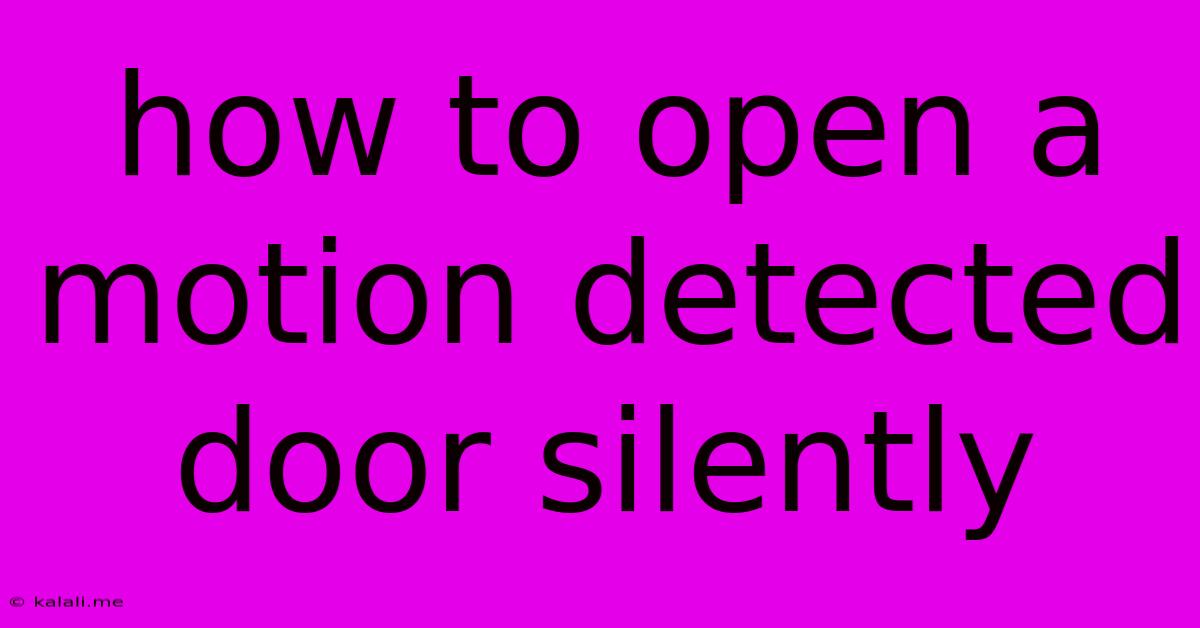How To Open A Motion Detected Door Silently
Kalali
Jun 07, 2025 · 3 min read

Table of Contents
How to Open a Motion-Detected Door Silently: A Comprehensive Guide
Meta Description: Learn how to bypass motion-detected doors silently and safely, exploring various techniques and considerations for different door types and security systems. This guide covers everything from understanding sensor technology to employing stealth tactics.
Motion-detected doors, while enhancing security, can present a challenge if you need to access a location discreetly. Whether you're a homeowner dealing with a malfunctioning system, a professional needing silent entry, or simply curious about the possibilities, understanding how to open these doors silently is crucial. This guide explores various approaches, focusing on safety and ethical considerations. Note: This information is provided for educational purposes only and should not be used for illegal activities.
Understanding Motion-Detected Doors
Before delving into techniques, it's essential to understand how these systems work. Most rely on passive infrared (PIR) sensors that detect changes in infrared radiation emitted by moving objects. Others utilize microwave sensors, detecting movement via Doppler radar, or ultrasonic sensors, employing sound waves. Each sensor type has its own strengths and weaknesses, impacting the effectiveness of silent entry methods.
Methods for Silent Entry
The method you choose will depend largely on the specific type of door and security system in place. There's no single "magic bullet," and success relies on careful observation and planning.
1. Masking Movement: This is the most common and effective approach. The goal is to avoid triggering the sensor by minimizing movement that would create changes in infrared radiation, microwave reflections, or ultrasonic wave patterns.
- Slow and Deliberate Movements: Move slowly and deliberately, avoiding jerky motions. Smaller, more controlled movements are less likely to trigger the sensor.
- Using Cover: Utilize any available cover, such as shadows or objects, to obscure your movements from the sensor's field of view.
- Low Profile: Crouch or crawl to minimize your profile and reduce the amount of infrared radiation detected.
2. Sensor Blind Spots: Many motion sensors have blind spots – areas they cannot effectively monitor. Identifying and utilizing these areas is crucial.
- Observe Sensor Placement: Carefully examine the sensor's location and orientation to determine its blind spots. These often exist close to the sensor itself or directly below it.
- Strategic Positioning: Position yourself within these blind spots before moving toward the door.
3. Jamming or Disabling the Sensor (Advanced and Risky): This is the most complex and potentially illegal approach and is strongly discouraged unless you are a qualified professional. It requires specialized knowledge and equipment, and it's extremely important to understand the legal implications.
4. Alternative Entry Points: Before attempting any method involving the door's security system, consider alternative access points. A window, back door, or even a less secure area could provide a simpler solution.
Considerations for Different Door Types
The type of door itself affects the feasibility of silent entry.
- Sliding Doors: These are generally easier to manipulate silently as they don't require hinges or latches that can make noise. However, they often have more complex sensors.
- Swinging Doors: These require more delicate maneuvering to avoid creaking or banging. Lubricating hinges beforehand can help minimize noise.
- Doors with Magnetic Contacts: These sensors detect when the door is opened. Carefully manipulating the magnetic contact without triggering the alarm can be difficult and requires precise movements.
Ethical and Legal Implications
It is crucial to remember that attempting to bypass security systems without authorization is illegal and unethical. This information is provided for educational purposes only and should only be used in situations where you have explicit permission. Always prioritize safety and legality.
Conclusion
Opening a motion-detected door silently requires a blend of patience, observation, and strategic thinking. While various methods exist, each carries its own level of complexity and risk. Understanding sensor technology and employing the most appropriate approach are paramount. Remember to always act legally and ethically, and prioritize personal safety.
Latest Posts
Latest Posts
-
How To Replace A Front Door
Jun 07, 2025
-
How To Eliminate Musty Basement Odor
Jun 07, 2025
-
How Many Ml Is In A Glass Of Wine
Jun 07, 2025
-
What Hjjappens When You Die In Bio Shock
Jun 07, 2025
-
What Zodiac Sign Is February 19
Jun 07, 2025
Related Post
Thank you for visiting our website which covers about How To Open A Motion Detected Door Silently . We hope the information provided has been useful to you. Feel free to contact us if you have any questions or need further assistance. See you next time and don't miss to bookmark.